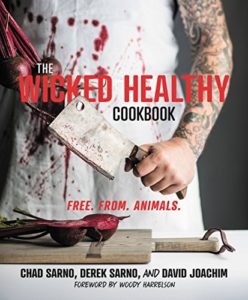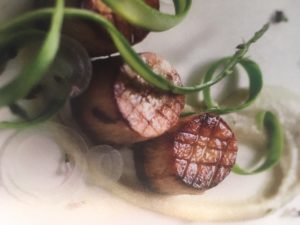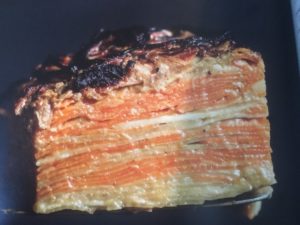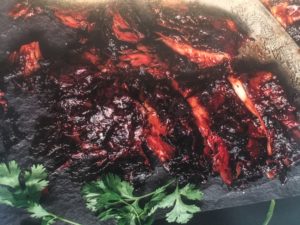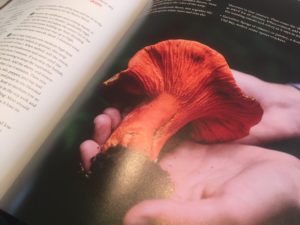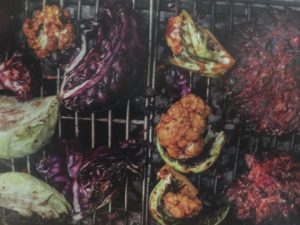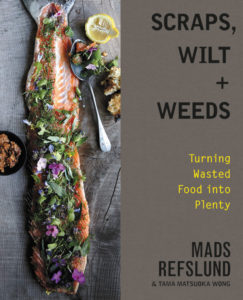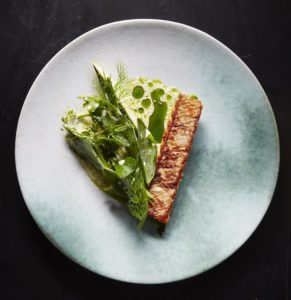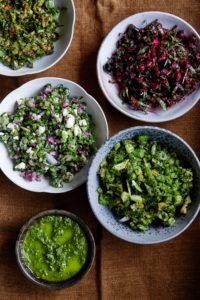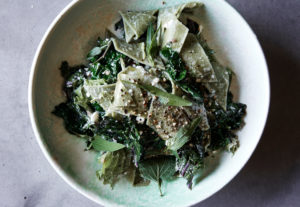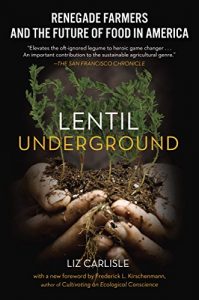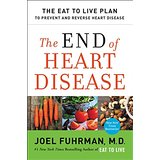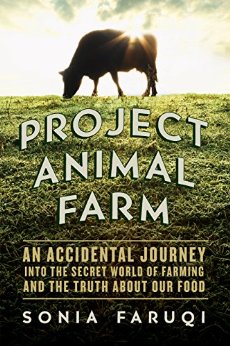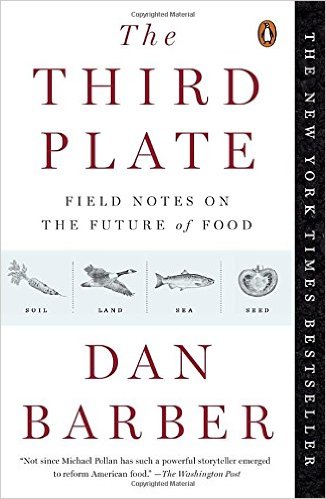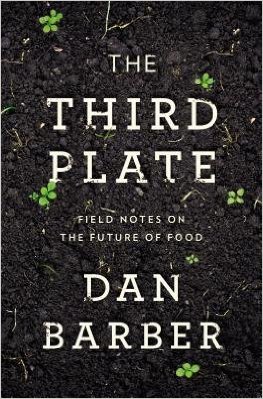Category Archives: Books You Need to Read
The Wicked Healthy Cookbook – Free. From. Animals. (Preliminary Review)
By Chad Sarno, Derek Sarno, and David Joachim
Grand Central Life & Style, Hachette Book Group, New York, NY 2018 $30
I love this book!!! From the minute it arrived, I was lost. Just skimming the essays, lists, Pro Tips and stunning recipes and images took me into the wee hours. Putting it down was not an option. Granted, my guilty pleasure is reading cookbooks. But this is a very special tome. Just when it felt like plant-based cuisine had reached its limits, with book after book adding a few new spins but churning the same ground, Wicked Healthy has seriously upped the ante. It’s fun, exciting, innovative, energetic, – the enthusiasm for the possibilities of plant-based gastronomy leaps off the pages. Dust off that mandoline!
To be clear this is not a book for every veg-forward cook. It is not an intro to the philosophy or a beginners’ guide. Some of the recipes are challenging, time-consuming and utilize esoteric ingredients that may require the resources of Whole Foods, Amazon, H-Mart, Thrive, a sophisticated farmers market and a few small mail-order houses – and even then you may have to be satisfied with recommended subs. It’s also, not surprisingly, a bit cheffy – many ingredients lists include other recipes so, unless you have a staff, there is sometimes serious time required. But it will be well-spent, satisfying time – even the process of discovering new or less-available ingredients will be well-spent, satisfying time. Bottom line, if all you do is just read The Wicked Healthy Cookbook, you can’t help but appreciate the expanded possibilities of plant-based cookery.
This is just my first review. I am going to cook my way through a good chunk of the book and post the results as I go. Starting with their bold new take on mushrooms: King Oysters, Maitakes, and Lobsters. What fun!! I can’t wait.
(One question – olive oil instead of avocado oil for high heat cooking?)
Glorious Food Waste
For decades, I have been gently chided, and occasionally mocked, for my kitchen frugality. A drawer filled with wilting produce sets off a visceral reaction leading to aggressive cooking. I don’t think it’s cheapness, as much as it’s a deep-seated concern about waste. Over the years, cooking teachers have denigrated the big, re-purposed Ziplock in my freezer chock full of plant scraps and leavings; apparently only pristine produce is good enough to make vegetable stock or fruit sauces. But still I persisted because, frankly, that just didn’t make any sense to me. And, besides, I just can’t empty that seemingly still good food into the trash or compost heap.
A short while ago, I stumbled on a wonderful “cookbook” Scraps, Wilt + Weeds written by Mads Refslund and Tama Matsuoka Wong. Refslund was a co-founder of world-famous Danish restaurant, Noma, and, shockingly, shares my visceral reaction to wilting, near-rotting produce! But he goes many steps beyond just making vegetable stock, dry-roasting just-past-prime produce, stewing less than perfect fruit into sauces and, of course, freezing very ripe bananas for breads and smoothies. Mads Refslund has elevated waste to haute cuisine.
The concepts are invigorating and inspirational – with stunning photographs that make near garbage extraordinarily beautiful. I use the word concept advisedly – to me the recipes are more conceptual than standard “multi-user-tested” ones. This is relatively new turf and the reader needs more guidance as to when, for instance, a tomato is near rot or just plain rotten. Even though I am a fairly accomplished home cook and long-time rescuer of wilted produce, I often had questions. For instance, a couple years ago I made carrot-top pesto from gorgeous, young CSA carrots and it was so bitter, it was inedible – why wasn’t his?
On the other hand, he encourages flexibility – use what you have (less, more or sub something else) rather than create more waste by buying to meet the specific recipe requirements. Other chapters focus on buying “ugly” produce, foraging for “weeds” and even using discarded fish parts. All told, it is a glorious paean to the minimization of waste and as I reluctantly released my non-renewable library copy, I concurrently added it to my Amazon list.
Mads Refslund has vindicated my kitchen frugality while he introduced others on whose shoulders he stands; those who have been long proselytizing waste reduction but who did not have his bully pulpit**. He has made reducing food waste sexy and chic. What a stunning, unbelievable accomplishment!! This is a book to own – a reference to stiffen our spines and alter our perceptions when we are about to sweep the leavings into the Waste King or the compost pot.
Why is this book so important? Every year, roughly 30% of all the food raised on the planet for human ingestion is literally wasted. If you just look at first world countries that number is even higher with the U.S. leading the pack at over 40%. According to the World Economic Forum, our global population is projected to reach 9.6 billion by 2050 – raising the leading question: how do we feed everybody? The United Nation’s FAO (Food & Agriculture Organization) posits that we already grow enough food, we just have to figure out how to save that 30-40% that we are currently wasting – which represents about 28% of the earth’s agricultural land. A whopping 25 percent of that waste is imperfect produce left in the fields to rot and 15% comes from tossed out, perfectly edible, food. (An additional, crucial, benefit would be to save the carbon footprint of all that wasted food –according to the EPA, landfills account for 34% of all U.S. methane emissions.)
** I am reading some of the author’s references and will share reviews and content in future posts.
The Lentil Underground – Renegade Farmers and the Future of Food in America
by Liz Carlisle, Avery 2015 $16 (Amazon $12)
An improbable group of renegade Montana farmers, led by David Oien, a former philosophy student, fight against Big Ag, local conventional farmers, GE seeds and worn-out soil to launch a sustainable business. Oien decided to return to his family’s 280-acre farm and, defying the regional orthodoxy, grow organic lentils – the edible seeds of plants that return nutrients to the soil.
Generally considered part of a family of weed crops, lentils are actually a very marketable commodity; they’re an inexpensive protein that’s rich in fiber, B1, folate, and amino acids, that doesn’t require irrigation and makes its own fertilizer. But marketing this Big Sky strain of organic small, black Beluga lentils to other potential growers as well as to the country’s distant taste-makers became the challenge. He needed help and that support emerged from unexpected places.
A number of remarkable farmers and other characters populate this tilting-at-windmills drama including buttoned-up, financial whizzes Doug and Anna Crabtree, the conservative Christian homesteading Manuel family, Senator-Organic farmer Jon Tester, eco-friendly builder and jack-of-all-trades Bud Barta along with a half dozen others. With their help, David Oien founded Timeless Natural Foods and grew it into a million dollar business that includes several unique lentil products and a full complement of other high-end quality grains.
To do that, he first had to convince chefs to try his lentils and then put them on their menus highlighting these unique Beluga Lentils. Word spread within the culinary world which netted Oien contracts with Trader Joe’s and Whole Foods and hundreds of smaller healthy food stores (some of which came with hard lessons and losses). But Orien persevered and his network of growers stood by him.
Almost as interesting, is the story of the book’s Montanan author: Harvard & UC Berkley trained, former country singer Liz Carlisle also served as Legislative Correspondent for Agriculture and Natural Resources in the Office of U.S. Senator Jon Tester. Today she is a Lecturer in the School of Earth, Energy, and Environmental Sciences at Stanford University, where she teaches courses on food and agriculture, sustainability transition, and environmental communication. Dr. Carlisle approaches her subject “The Lentil Underground” by integrating deeply-felt stories about the pioneers who risked all to farm holistically with clear, exceptional essays on the science of farm ecology.
Good Clean Food Shopping Smart to Avoid GMOs, rBGH and Products that may cause Cancer and other Diseases
By Samuel Epstein, MD and Beth Leibson – Skyhorse Publishing 2013. $24.95/ Amazon $16.99, $6.50 used
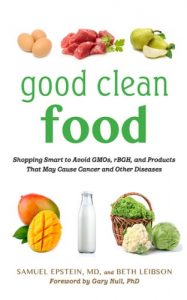
Dr. Epstein is a voice we should hear. His long and deep expertise on the avoidable causes of cancer has been shared in twenty books and 270 peer-reviewed articles. He is professor emeritus of environmental and occupational medicine at the University of Illinois School of Public Health and chair of the Cancer Prevention Coalition. He has also served as president of the Rachel Carson Council and other industry organizations. Co-author Beth Leibson knowledgeably unpacks this far-ranging erudition to make it accessible and understandable to the layperson.
This is a short read outlining important concepts that are clearly described – the main foci are:
Milk – the US permits the injection of the genetically-engineered growth hormone (rBGH – named by Monsanto Posilac) into dairy cows which causes elevated concentrations of IGF-1 (Insulin-like Growth Factor). The upside is that it increases milk production by 11-15%, the downside for the cow is that they get sick, for instance 25% get mastitis which adds more pus to the milk and which also requires antibiotics. About 20% of dairy farms in the US inject their herds with rBGH which creates IGF-1 but, since labeling is not required, consumers have no idea. The downside for the consumer, in addition to the antibiotic load, is that IGF-1, which is not destroyed by pasteurization, encourages cells to grow – in children it’s usually bones and organs, in adults it can be cancer cells. So, if you choose to continue to use dairy products, buy only organic from grass-fed herds. BTW: The EU and Canada outlawed rBCH and IGF-1 in the 90s. Better yet – plant milk.
Beef – Starting in the ‘50s, US cattle have been injected and/or fed a wide variety of sex hormones and other growth drugs. Today that cocktail, injected into 90% of all US cattle, contains natural estradiol, testosterone, and progesterone plus synthetic hormones zeranol, trenbolone, and melengesterol – all designed to add quick weight and roughly $80 additional profit per animal. The EU outlawed this practice in 1989. Industrial farmed meat cows are also fed prophylactic antibiotics which has contributed to the creation of superbugs that jump to humans and are resistant to most if not all antibiotics. Other beef topics include nitrates (and the link between hot dogs and pediatric brain cancer), radiation, the significant advantages of grass-fed beef and, again, the need for labeling.
Produce – The Dirty Dozen/Clean Fifteen – The Environmental Working Groups master list of the dozen most likely fruits and vegetables, when conventionally grown, to be drenched with pesticide – add kale and collards to the EWG list. The Clean Fifteen lists those least likely to be tainted. The authors also suggest buying “American” since imported produce usually contains higher percentages of pesticides. This chapter then details the negative effects of these insecticides and herbicides, many of which contain Organophosphates, which has been shown to block acetylcholinesterase that stops nerve cells from firing. The demonstrated effects include increased incidences of ADHD, autism, reduced memory and lowered IQ. The answer is organically grown produce.
Corn and Soybeans & GMOs – These are the two most prolific foods on the planet; corn, for instance, provides over 20% of all human nutrition – but both are largely used for animal feed. Both can be cultivated as vegetables or as oil or as…. The broad-spectrum herbicide Roundup, a ramped up version of Glyphosate (which is a type of organophosphate), was developed by Monsanto to increase field yields. Monsanto also developed many Roundup-ready, patented crop seeds that can tolerate the pesticide. Initially Roundup works, but then, over time, the weeds become resistance and the farmers find it necessary to increase the quantity of Roundup creating more dangerous conditions for farmers and consumers. Glyphosate-resistant alternatives exist but share the same problems – they kill off amphibians as well as pests and weeds and they contain an inert ingredient (a surfactant) to help the chemicals penetrate the plants which has shown to be harmful to humans. A newcomer is Bt corn (Bacillus thuringiensis), a plant that exudes its own pesticide which is also dangerous to other living things, like butterflies and humans. The chapter concludes with a review of the politics as well as alternatives – especially non-GMO organic.
Chicken & Eggs – Conventionally raised chickens (and eggs) are fed a wide range of ingredients to encourage speedy growth including prophylactic antibiotics – which pass to humans creating similar problems to those of beef. At first brush, the answer seems to be organic. In order to be labeled organic, broilers and egg-laying hens alike, must be fed organic feed without antibiotics (except for illness), hormones or pesticides and they must have access to the outdoors. An organic egg comes from an organic laying hen. But beware the various levels of “organic” – large-scale industrial and some family-size organic egg farms may offer an open door with an impenetrable maze to access it so there is no “scratching in the dirt.” The key descriptor seems to be “pasture-based” or “free-range” organic where mobile housing moves frequently to fresh fields and the birds are outdoors as often as inside. All of this applies to “broilers” as well.
Avoiding GMOs – This gets harder every day; again look for the word “organic” otherwise almost any, for instance, soybean or soybean derivative will likely be from GMO plants– but at least know the legal definitions: “100% organic” means just that. “Organic” means 95% of ingredients are. “Made form Organic Ingredients” 70-94% is organic. The word “organic” on the ingredient panel only means that less than 70% is organic. An on fruits and vegetables – look for a label with a 5-digit number beginning with 9 – that’s organic. Beginning with an 8 means GMO (but that’s rarely labeled). Four digits beginning with 3 or 4 means conventional.
The remainder of the book discusses detoxification and future trends like Budget organics – private labels, Farmers’ markets, CSAs Buying clubs, Food Co-ops. And trends among various ethnic groups and around the world – all of which are well worth reading. Finally check out the organic industry watch dog: Cornucopia Institute www.cornucopia.org.
The End of Heart Disease
by Joel Fuhrman, MD, Harper One, 2016
According to Dr. Furhman, his Nutritarian Diet will make it impossible to have a heart attack, while it reverses obstructive coronary artery disease (CAD) and radically lowers your cholesterol and blood pressure, reduces your weight, restores normal bowel function, improves your immune function and maintains youthful vigor in the face of aging. Fuhrman’s Nutritarian diet can be totally plant-based or it can be flexitarian which includes some animal products albeit in very small quantities (three small servings a week). But in either case, it is predominantly vegetables, beans seeds and nuts. The goal is a diet that is nutrient dense, hormonally favorable (avoiding, especially, excess insulin and insulin growth factor [IGF-1]), nutritionally adequate (including all essential nutrients), and avoids toxins. The basis for the diet’s choices are ANDI scores (Aggregate Nutrient Density Index) that ranks foods based on the nutrients delivered for each calorie consumed.
Project Animal Farm: an accidental journey into the secret world of farming and the truth about our food
by Sonia Faruqi. 2016 Pegasus Books List $27.95, HD $19, PB $16.95, Kin $14
Ms. Faruqi, a former Wall Streeter, decided to volunteer at a Canadian organic dairy farm and that started an international journey to explore animal agriculture. Her up-close and personal experiences – from Canada to Indonesia, Malaysia, Singapore, Dubai, Mexico, Belize, and finally the US – are interspersed with relevant facts and figures about animal farming. A focused, topic-specific memoir (with extensive references) as opposed to a traditional investigative reporting piece, it is nevertheless a compelling read. The distressing, horrendous descriptions of a world gone horribly awry are lightened by a very few rays of hope. Ms. Faruqi concludes with the following solutions (which she has demonstrated throughout the book): 1. Large pastoral farms – reflecting crucial economies of scale – are the future ideal. 2. Genetic selection has created animals that are unable to function properly promulgating unnatural behaviors. 3. Gender diversity among famers needs to increase – more women!! 4. Agribusiness needs to police itself, recognize the obvious problems and create solutions. 5. Farm inspections need to be done by independent third parties. 6. Farm animals need regulations that recognize they are sentient beings and treat them as such (see #5). 7. Labels have to make sense and be enforced – for instance, the label “organic” (theoretically the most specific and meaningful term) is often achieved with lip service, blatant abuse and loopholes (see #5).
